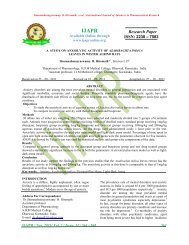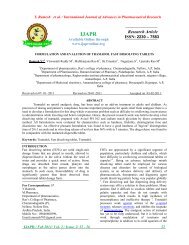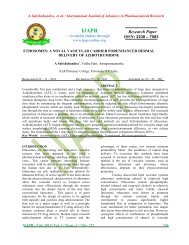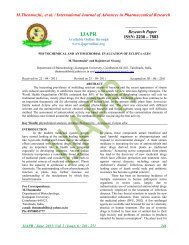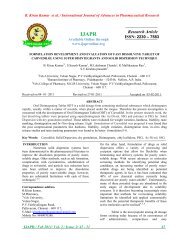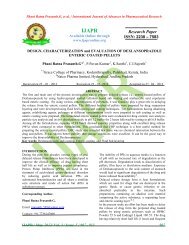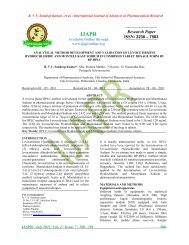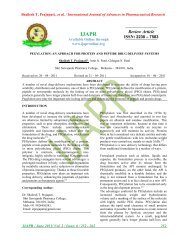ijapr - international journal of advances in pharmaceutical research
ijapr - international journal of advances in pharmaceutical research
ijapr - international journal of advances in pharmaceutical research
Create successful ePaper yourself
Turn your PDF publications into a flip-book with our unique Google optimized e-Paper software.
M.S Latha et al. / International Journal <strong>of</strong> Advances <strong>in</strong> Pharmaceutical Research<br />
the process, which is followed by regeneration,<br />
growth and clonal proliferation, eventually lead<strong>in</strong>g to<br />
cancer (5). There is extensive evidence that the free<br />
radicals participate <strong>in</strong> NDEA <strong>in</strong>duced<br />
hepatocarc<strong>in</strong>ogenesis (6). Enzymes such as GST, GR<br />
and GPx reduce oxidative stress <strong>in</strong> the normal tissues.<br />
Extensive liver damage causes decrease <strong>in</strong> levels <strong>of</strong><br />
these enzymes suggest<strong>in</strong>g a high oxidative stress <strong>in</strong><br />
the tissues, which may be one <strong>of</strong> the key factors <strong>in</strong><br />
the etiology <strong>of</strong> cancer (7). They have been proved to<br />
cause numerous cellular anomalies, <strong>in</strong>clud<strong>in</strong>g but not<br />
limited to prote<strong>in</strong> damage, deactivation <strong>of</strong> enzymatic<br />
activity, alteration <strong>of</strong> DNA and lipid peroxidation <strong>of</strong><br />
membranes (8). Several herbal drugs like Abrus<br />
precatorius, Scutia myrt<strong>in</strong>a, Funaria <strong>in</strong>dica etc. have<br />
been evaluated for its potential as liver protectant<br />
aga<strong>in</strong>st NDEA <strong>in</strong>duced hepatocellular carc<strong>in</strong>oma <strong>in</strong><br />
rats (9- 11).<br />
Chemoprevention, which is referred to as the use <strong>of</strong><br />
nontoxic natural or synthetic chemicals to <strong>in</strong>tervene<br />
<strong>in</strong> multistage carc<strong>in</strong>ogenesis, has emerged as a<br />
promis<strong>in</strong>g and pragmatic medical approach to reduce<br />
the risk <strong>of</strong> cancer. Numerous components <strong>of</strong> plants,<br />
collectively termed “phytochemicals” have been<br />
reported to possess substantial chemopreventive<br />
properties. For many years cancer chemotherapy has<br />
been dom<strong>in</strong>ated by potent drugs that either <strong>in</strong>terrupt<br />
the synthesis <strong>of</strong> DNA or destroy its structure once it<br />
has formed. Unfortunately, their toxicity is not<br />
limited to cancer cells and normal cells are also<br />
harmed (12).<br />
Use <strong>of</strong> plants and plant derivatives considered as<br />
alternative medic<strong>in</strong>e for many ailments are on the<br />
<strong>in</strong>crease on a global perspective. Woodfordia<br />
fruticosa is a traditional medic<strong>in</strong>al plant belongs to<br />
the family Lythraceae is used aga<strong>in</strong>st a wide variety<br />
<strong>of</strong> diseases. All parts <strong>of</strong> the plant possess valuable<br />
medic<strong>in</strong>al properties such as anti <strong>in</strong>flammatory,<br />
antitumor, hepatoprotective and free radical<br />
scaveng<strong>in</strong>g activity but flowers are <strong>of</strong> maximum<br />
demand. Dried flowers are used as tonic <strong>in</strong> disorders<br />
<strong>of</strong> mucous membrane, hemorrhoids and <strong>in</strong><br />
derangement <strong>of</strong> liver (13). Phenolics, particularly<br />
hydrolysable tann<strong>in</strong>s and flavonoids were identified<br />
as major components <strong>in</strong> Woodfordia fruticosa<br />
flowers. In view <strong>of</strong> these the present study was<br />
undertaken to evaluate the chemopreventive effect <strong>of</strong><br />
Woodfordia fruticosa flower extract on NDEA<br />
<strong>in</strong>duced hepatocellular carc<strong>in</strong>oma <strong>in</strong> experimental<br />
rats.<br />
2. MATERIALS AND METHODS<br />
2.1 Chemicals<br />
N-nitrosodiethylam<strong>in</strong>e (NDEA), silymar<strong>in</strong>,<br />
proliferat<strong>in</strong>g cell nuclear antigen (PCNA), cycl<strong>in</strong> D1,<br />
anti-mouse IgG horse radish peroxidase, streptavid<strong>in</strong><br />
horse radish peroxidase conjugate and<br />
diam<strong>in</strong>obenzid<strong>in</strong>e were purchased from Sigma<br />
Chemical Co., St. Louis, MO, USA. Assay kits for<br />
serum aspartate am<strong>in</strong>otransferase (AST), alan<strong>in</strong>e<br />
am<strong>in</strong>otransferase (ALT) and gamma glutamyl<br />
transferase (GGT) were purchased from Agappe<br />
Diagnostics, India. All other chemicals were <strong>of</strong><br />
analytical grade.<br />
2.2 Collection <strong>of</strong> plant material and preparation <strong>of</strong><br />
plant extracts<br />
Woodfordia fruticosa flowers were collected from<br />
natural habitat (Kollam, Kerala, India) dur<strong>in</strong>g<br />
November - January. Plant material was identified by<br />
Dr. V.T Antony, S.B College. A voucher specimen<br />
(Acc. No. 7566) is deposited at the herbarium <strong>of</strong> the<br />
Department <strong>of</strong> Botany, S.B College, Changanassery,<br />
Kottayam, Kerala. Flowers were shade-dried and<br />
powdered and 50 g <strong>of</strong> dried powder was soxhlet<br />
extracted with 400 mL <strong>of</strong> methanol for 48 h. The<br />
extract was concentrated under reduced pressure<br />
us<strong>in</strong>g a rotary evaporator and was kept under<br />
refrigeration. The yield <strong>of</strong> methanolic extract <strong>of</strong><br />
Woodfordia fruticosa (MEWF) was 12.5 % (w/w).<br />
The concentrate was suspended <strong>in</strong> 5% Tween 80 for<br />
the present studies.<br />
2.3 Animals and diets<br />
Male Wistar rats weigh<strong>in</strong>g 150-160 gm were used <strong>in</strong><br />
this study. The animals were housed <strong>in</strong><br />
polypropylene cages and had free access to standard<br />
pellet diet (Sai Durga Feeds, Bangalore, India) and<br />
dr<strong>in</strong>k<strong>in</strong>g water. The animals were ma<strong>in</strong>ta<strong>in</strong>ed at a<br />
controlled condition <strong>of</strong> temperature <strong>of</strong> 26–28 o C with<br />
a 12 h light: 12 h dark cycle. Animal studies were<br />
followed accord<strong>in</strong>g to Institute Animal Ethics<br />
Committee regulations approved by Committee for<br />
the Purpose <strong>of</strong> Control and Supervision <strong>of</strong><br />
Experiments on Animals (Reg. No. B 2442009/4) and<br />
conducted humanely.<br />
2.4 Induction <strong>of</strong> hepatocellular carc<strong>in</strong>oma<br />
Hepatocellular carc<strong>in</strong>oma (HCC) was <strong>in</strong>duced by oral<br />
adm<strong>in</strong>istration <strong>of</strong> 0.02% NDEA (2ml, 5 days/week<br />
for 20 weeks (12). Silymar<strong>in</strong> at an oral dose <strong>of</strong> 100<br />
mg/kg body weight was used as standard control <strong>in</strong><br />
the experiment (14-15). Two different doses <strong>of</strong><br />
MEWF (100mg/kg and 200 mg/kg) suspended <strong>in</strong> 5%<br />
Tween 80 were prepared for oral adm<strong>in</strong>istration to<br />
the animals. It is reported that the extract <strong>of</strong> W.<br />
fruticosa flowers are safe up to the dose <strong>of</strong><br />
2000mg/kg, p.o (13).<br />
2.5 Experimental design<br />
IJAPR / Dec. 2012/ Vol. 3 /Issue. 12 / 1322 – 1330 1323



